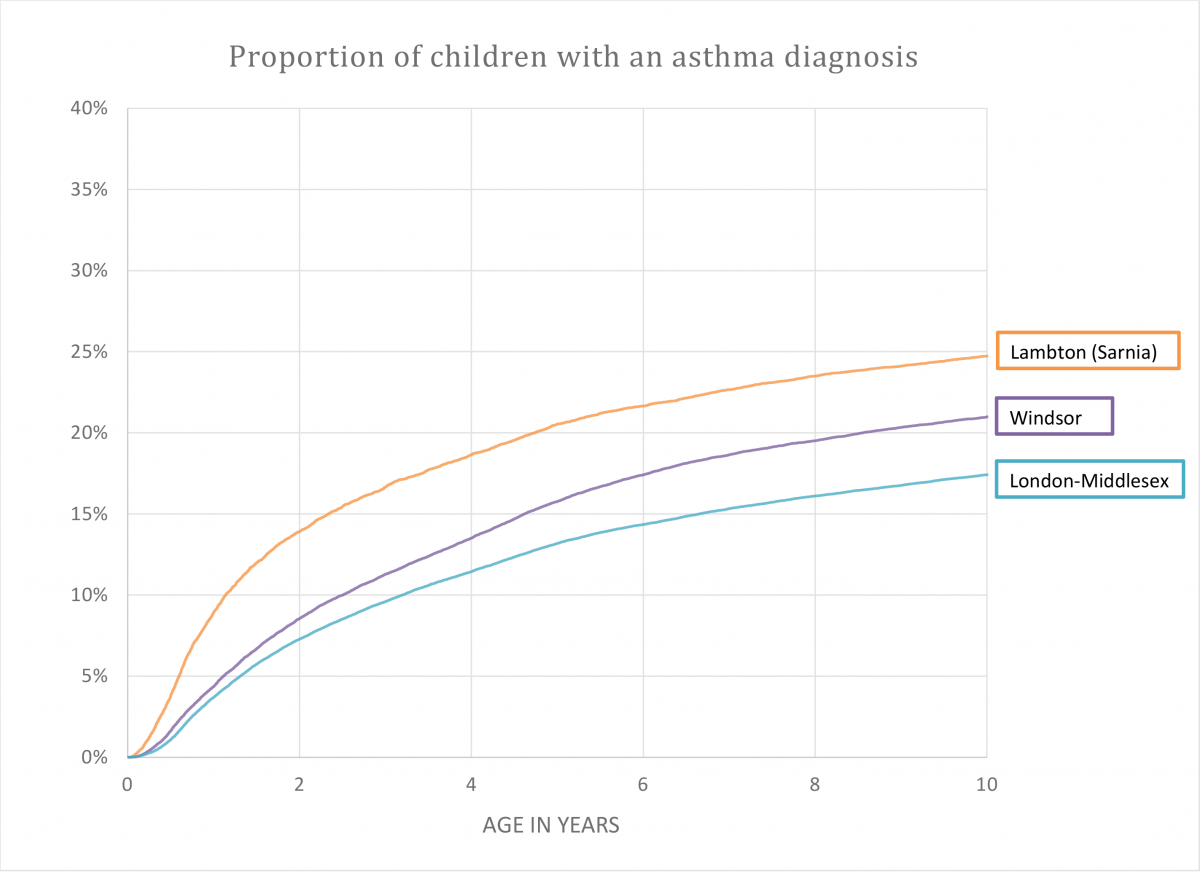A new population-based study from researchers at Lawson Health Research Institute and Western University finds that children born in Sarnia have a higher chance of developing asthma than their neighbours in London and Windsor.

The study looked at 114,427 children born in the three cities between April 1993 and April 2009, and tracked them over a period of 10 years using provincial data from the non-profit health research group ICES.
Researchers found that by 10 years of age, nearly a quarter of children in Sarnia had been diagnosed with asthma, compared to 21 per cent in Windsor and 17 in London.
The findings, published in CMAJ Open, an online open-access journal started by the Canadian Medical Association Journal, were present even after adjusting for confounders associated with asthma risk, including sex, socioeconomic factors, and urban versus rural setting, the study says.
“Our interest, in particular, was to look at whether air pollution might be contributing to this risk,” said Dr. Dhenuka Radhakrishnan, adjunct ICES scientist, pediatric respirologist, and one of the study’s authors.
“Indeed, we did find a nice correlation between higher levels of air pollution in Sarnia and higher levels of asthma, and in converse, lower levels of air pollution in Windsor and in London and lower levels of asthma there.”
The study says that higher air pollution exposure in the first year of life was very likely a contributing factor. Researchers found that higher levels of sulphur dioxide and small particulate matter were present in the first year of life for the children they were following who were born and living in the Sarnia area.
“What we found was that even though the levels of traffic pollution were similar between the two cities, particularly Windsor and Sarnia, though a bit lower in London, it was specifically these types of pollutants that are more related to industry that were very high in Sarnia compared to the other two regions,” Radhakrishnan said.

Get weekly health news
The southern end of the city, and much of its shoreline along the St. Clair River, is dotted with large chemical and petrochemical plants and refineries which have earned it the moniker “Chemical Valley.”
Roughly 40 per cent of Canada’s petrochemical industry is packed into Chemical Valley, and there were at least 57 industrial polluters registered with the Canadian and U.S. governments within 25 kilometres of Sarnia as of 2017.
The study says there is growing evidence that exposure to air pollutants during pregnancy can influence development of asthma in children.
“The good news is that we’ve seen a decrease in air pollution levels in all three regions over the last 10 years or so, and at the same time, we’ve seen a nice decrease in the rate of new asthma cases in those same places as well,” Radhakrishnan says.
The study also suggests lower smoking rates and increases in protective factors, such as breastfeeding, may have also played a role in decreases in the incidence of asthma.
The findings of the Lawson story come a day ahead of World Asthma Day, which aims to raise awareness of the inflammatory condition which impacts the lives of more than 330 million people around the world, according to the World Health Organization.
“For the vast majority of children, asthma is a mild condition,” Radhakrishnan said.
“But in some children, asthma is associated with more severe symptoms, sometimes flare ups that bring them recurrently to the emergency department or even, at times, needing to be hospitalised to treat their symptoms.”
Radhakrishnan and the other researchers say the findings highlight the importance in finding strategies to prevent the development of asthma, including through further reductions in air pollution and air pollution exposure by pregnant people and young children.
Concerns about significant air and water pollution linked to Chemical Valley have made headlines for decades, including a notorious incident in 1985 when Dow Chemical spilled roughly 11,000 litres of the toxic dry-cleaning solvent perchloroethylene into the St. Clair, resulting in a massive ‘blob’ near the bottom of the river.
The blob, which contained more than a dozen contaminants picked up from the river sediments, was later cleaned up at a cost of around $1 million. The incident dealt a harsh blow to the city’s reputation.
Chemical Valley was also the basis of a major joint investigation in 2017 by Global News, the Toronto Star, the National Observer, Michener Awards Foundation and journalism schools at Ryerson and Concordia which exposed a troubling pattern of potentially toxic spills and leaks that put the health of residents in Sarnia and Aamjiwnaang First Nation at risk.














Comments